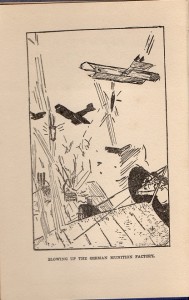Book Review: Air Service Boys Over the Rhine by Charles Amory Beach
In 1916, America was still officially neutral in the matter of the Great War. While many Americans didn’t much like the way Germany was attacking its neighbors, the government felt that it was really none of our business. Still, some Americans felt compelled to come to France to aid the valiant French in the defense of their homeland. Some of them were trained pilots, or swiftly educated as such, and became the Escadrille Américaine; after a formal German protest, they were renamed the Lafayette Escadrille after the French soldier who’d helped out the Americans during their revolution. The “Air Service Boys” series celebrates these young heroes.

In this, the third book of the series, Tom Raymond and Jack Parmley, two of the American pilots, are having a relatively slow week when the mail arrives, letting Tom know that his inventor father is soon to arrive in Paris. Some time passes as missions are flown, but no further message comes from Mr. Raymond. The boys decide to take their next leave in Paris, to see if the inventor has simply not had his mail delivered.
The boys arrive just in time for a new example of German “frightfulness” (deliberately brutal attacks that have little military value, designed to terrorize and demoralize the enemy public.) The Germans are somehow dropping bombs on random parts of Paris, despite no aircraft in the sky, and no artillery close enough to send shells. Deuced bad luck for our lads when they finally track Tom’s father down, only to learn that his building is one of the bomb targets. No body found, but no word of survival either.
Eventually, the secret of the Big Bertha guns is revealed, and the boys join the strike force to take them out. Once that’s done, it’s time to strike back against the perfidious enemy. A long range mission over the Rhine brings our lads to bomb a German munitions factory. They’re forced down behind enemy lines, and find their escape aided by the most obvious person.
This is very much a children’s book, with many terms explained in the simplest fashion. There isn’t much in the way of characterization–Jack is slightly more impulsive than Tom, and is sweet on a girl named Bessie. Bessie and her mother barely appear, just long enough to let us know they are contributing by working for the Red Cross, then getting kidnapped by German spies offstage. (And rescued offstage as well.) A German spy appears just enough to let us know the enemy is still treacherous–our heroes never directly interact with him.
The dialogue is stilted, and the combat scenes oddly lifeless (though blood and death appear often enough, and Jack is hospitalized twice.) The author even halts the action for a chapter to tell us what happened in the first two books in some detail. There’s quite a bit of period ethnic prejudice against Germans, and frequent use of the slurs “Boche” and “Hun.”
If you are famished for tales of the Lafayette Escadrille, I see there is a collected edition of four books in this series available on Kindle for a reasonable price. I really can’t recommend this book on its own.
And now, another highly fictionalized version of the Escadrille:
